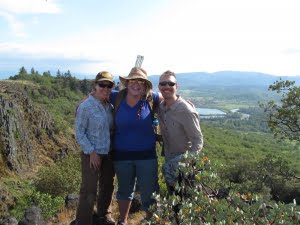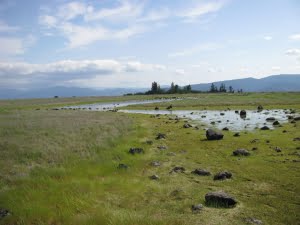
Greetings from Table Rocks
It’s been a crazy month filled with field work, lots of laughs, and a bit of poison oak (more on that in a blog to come)! Traveling back to a few weeks ago, however, we started our field season at Table Rocks. Table Rocks is a geological formation outside of Medford, OR, resulting from millions of years of geologic activity. The sedimentary rock that forms the Payne Cliff formation was deposited approximately 40 million years ago. The combined forces of erosion and uplift formed the Rogue valley and the Klamath mountains approximately 10 to 20 million years ago. Approximately 7 million years ago, lava flows flooded the ancestral Rogue River Valley and formed a hard cap over the Payne Cliff formation. Since then, the Rogue River has meandered through the Rogue Valley to erode most of the hard volcanic cap. The remnants are only a few monoliths including the Table Rocks formation.

The Rogue River Valley where the rocks are located has been an area of importance for Native Americans, specifically the Takelma people who inhabited the region approximately 15,000 years ago. Not only were the rocks an area of spiritual importance, but they depended upon the various amount of natural resources around the area such as camas bulbs, acorns, willow shoots, and iris leaves just to name a few. Currently, Table Rock is a popular area for recreation and education after being dedicated as a nature preserve by the Nature Conservancy in 1979. It is also still an important cultural location for the Takelma people who conduct various tribal ceremonies at the site. Not only do the rocks provide an excellent backdrop for environmental education, a representation of the rich historical culture, and a great place to spend an afternoon, but they are also home to Limnanthes pumila ssp. pumila (dwarf woolly meadowfoam), a sensitive species, which is endemic to Table Rocks.

Restoration
Research
Education
Contact
Main Office:
4950 SW Hout Street
Corvallis, OR 97333-9598
541-753-3099
info@appliedeco.org
Southwest Office:
1202 Parkway Dr. Suite B
Santa Fe, NM 87507
(505) 490-4910
swprogram@appliedeco.org
© 2025 Institute for Applied Ecology | Privacy Policy
